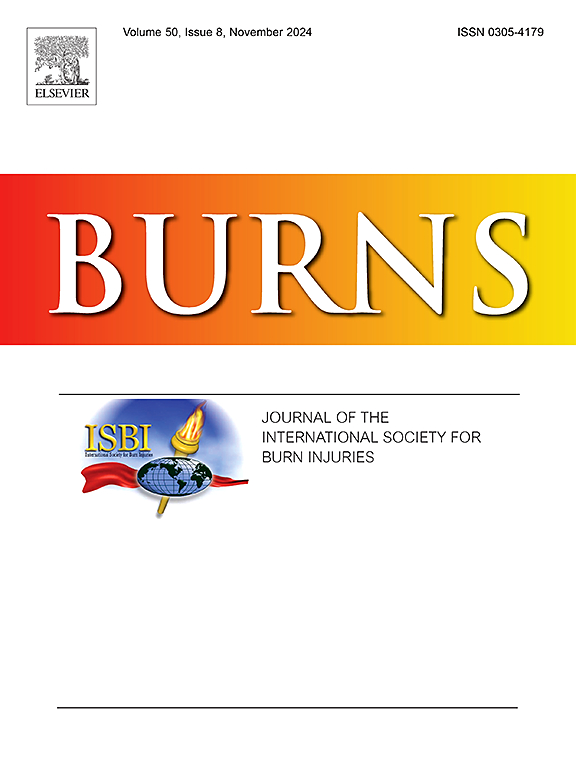Identification of the potential role of PANoptosis-related genes in burns via bioinformatic analyses and experimental validation
IF 3.2
3区 医学
Q2 CRITICAL CARE MEDICINE
引用次数: 0
Abstract
Background
The treatment of burns is highly challenging due to their complex pathophysiological mechanisms. PANoptosis, as an important form of cell death, is suggested to play a crucial role in the inflammatory response and tissue damage following burns. However, the role of PANoptosis-related biomarkers in the pathophysiological processes of burns remains unclear. In this study, we aim to identify PANoptosis-related signature genes and validate them as biomarkers in burns
Methods
Burn-related datasets were obtained from the Gene Expression Omnibus(GEO) database. GSE37069 was used for bioinformatic analysis and machine learning, while GSE19743 was used specifically for external validation. A set of PANoptosis-associated genes was obtained from the GeneCards database. Three machine learning models (LASSO, RF, and SVM-RFE) and WGCNA were utilized to screen for signature genes. The diagnostic efficacy of the identified genes was assessed through receiver operating characteristic (ROC) curves. Gene Set Enrichment Analysis (GSEA) was performed to identify pathways associated with the signature genes, while single-sample gene set enrichment analysis (ssGSEA) was employed to investigate the immune landscape. Finally, Western blotting and RT-qPCR were employed to validate the signature genes.
Results
BCL-2, CCAR1, CERK, TRIAP1, S100A8, and SNHG1 were identified as signature genes. The biological processes involving these genes mainly include endocytosis, apoptosis, and ECM receptor interaction. Immune infiltration analysis revealed that neutrophils, eosinophils, M0 macrophages, and monocytes are significantly elevated in burn samples. Additionally, these signature genes showed significant correlations with multiple immune cell types. Finally, Western blotting and RT-qPCR analysis revealed that the expression levels of BCL2, CCAR1, CERK, and TRIAP1 were significantly down-regulated in the burn groups compared to the normal groups, with the exception of S100A8.
Conclusion
Our study has identified BCL-2, CCAR1, CERK, and TRIAP1 as reliable potential biomarkers for burn injuries. These genes play crucial roles in immune response, wound healing, and anti-apoptotic mechanisms, which are key pathological processes involved in the progression of burn injuries. Specifically, BCL-2, CCAR1, CERK, and TRIAP1 have been shown to significantly impact the regulation of inflammation, the efficiency of wound repair, and the prevention of cell apoptosis during burn injury.
通过生物信息学分析和实验验证确定 PANoptosis 相关基因在烧伤中的潜在作用
背景:烧伤的病理生理机制复杂,其治疗具有很高的挑战性。PANoptosis作为一种重要的细胞死亡形式,在烧伤后的炎症反应和组织损伤中起着至关重要的作用。然而,panoposis相关生物标志物在烧伤病理生理过程中的作用尚不清楚。在这项研究中,我们旨在鉴定panoptosis相关的特征基因,并验证它们作为烧伤的生物标志物。方法烧伤相关数据集来自基因表达Omnibus(GEO)数据库。GSE37069用于生物信息学分析和机器学习,而GSE19743专门用于外部验证。从GeneCards数据库中获得一组panoptosis相关基因。使用三种机器学习模型(LASSO、RF和SVM-RFE)和WGCNA筛选签名基因。通过受试者工作特征(ROC)曲线评估鉴定基因的诊断效果。基因集富集分析(GSEA)用于识别与特征基因相关的途径,而单样本基因集富集分析(ssGSEA)用于研究免疫景观。最后,采用Western blotting和RT-qPCR对标记基因进行验证。结果鉴定出bcl -2、CCAR1、CERK、TRIAP1、S100A8和SNHG1为特征基因。涉及这些基因的生物学过程主要包括胞吞作用、细胞凋亡和ECM受体相互作用。免疫浸润分析显示,烧伤样品中中性粒细胞、嗜酸性粒细胞、M0巨噬细胞和单核细胞显著升高。此外,这些特征基因显示出与多种免疫细胞类型的显著相关性。最后,Western blotting和RT-qPCR分析显示,烧伤组BCL2、CCAR1、CERK和TRIAP1的表达水平较正常组显著下调,但S100A8除外。结论本研究已确定BCL-2、CCAR1、CERK和TRIAP1是可靠的潜在烧伤生物标志物。这些基因在免疫反应、伤口愈合和抗凋亡机制中起着至关重要的作用,这是烧伤进展的关键病理过程。具体而言,BCL-2、CCAR1、CERK和TRIAP1已被证明在烧伤过程中显著影响炎症调节、伤口修复效率和防止细胞凋亡。
本文章由计算机程序翻译,如有差异,请以英文原文为准。
求助全文
约1分钟内获得全文
求助全文
来源期刊

Burns
医学-皮肤病学
CiteScore
4.50
自引率
18.50%
发文量
304
审稿时长
72 days
期刊介绍:
Burns aims to foster the exchange of information among all engaged in preventing and treating the effects of burns. The journal focuses on clinical, scientific and social aspects of these injuries and covers the prevention of the injury, the epidemiology of such injuries and all aspects of treatment including development of new techniques and technologies and verification of existing ones. Regular features include clinical and scientific papers, state of the art reviews and descriptions of burn-care in practice.
Topics covered by Burns include: the effects of smoke on man and animals, their tissues and cells; the responses to and treatment of patients and animals with chemical injuries to the skin; the biological and clinical effects of cold injuries; surgical techniques which are, or may be relevant to the treatment of burned patients during the acute or reconstructive phase following injury; well controlled laboratory studies of the effectiveness of anti-microbial agents on infection and new materials on scarring and healing; inflammatory responses to injury, effectiveness of related agents and other compounds used to modify the physiological and cellular responses to the injury; experimental studies of burns and the outcome of burn wound healing; regenerative medicine concerning the skin.
 求助内容:
求助内容: 应助结果提醒方式:
应助结果提醒方式:


